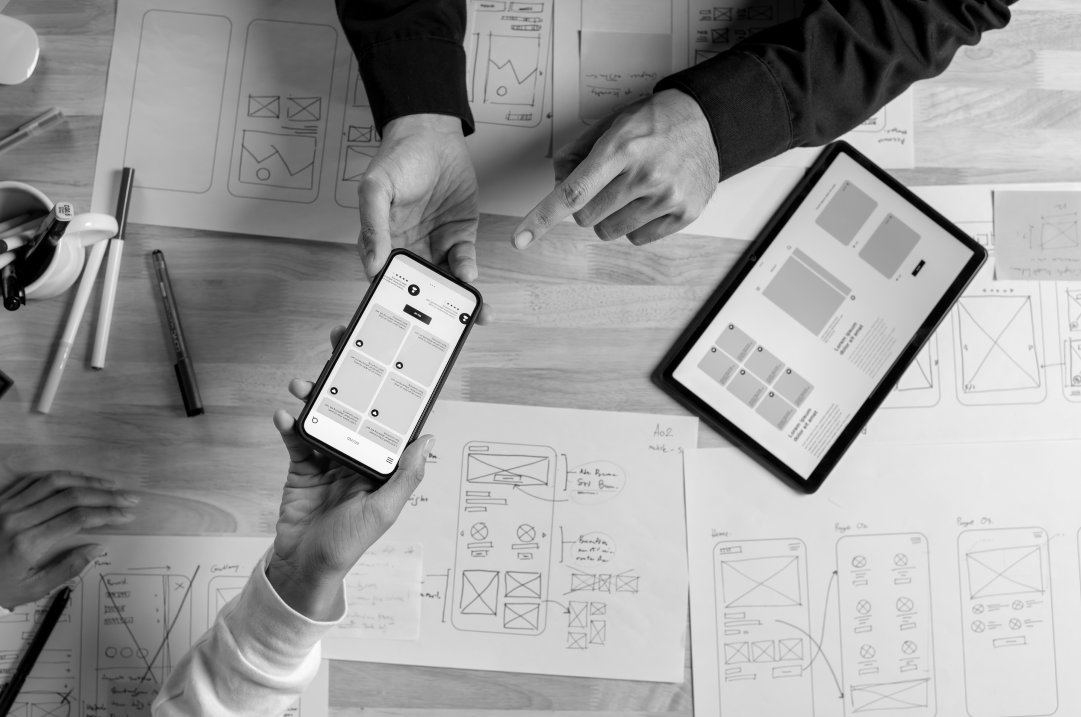In the fast-paced realm of app development, the conventional approach often feels like navigating a labyrinth blindfolded. However, the industry has a secret weapon – the almighty design sprint. This innovative methodology has been disrupting traditional development practices, ushering in a new era of efficiency and creativity. In today’s Brightscout blog post, we'll unravel the mysteries behind design sprints and explore how they stand tall against their traditional counterparts.
At its core, a design sprint is a time-boxed and highly structured collaborative methodology designed to swiftly solve complex problems and validate ideas. It was conceptualized as a means to compress the lengthy product development cycle into a mere five days. In essence, it's a week-long sprint that brings together a cross-functional team to ideate, prototype, and test potential solutions with real users. A design sprint is the perfect framework to explore new ideas, refine the user journey, and apply design thinking to create innovative solutions quickly and efficiently. Design sprints integrate user research and user testing into the product design process, helping teams create solutions that align with the customer journey and deliver impactful results.
The journey begins with a meticulously crafted agenda. The first day, aptly named "Understand," involves unpacking the challenge at hand, aligning team members, and dissecting the problem from every conceivable angle. It's essentially laying the groundwork, ensuring everyone is on the same page before the sprint kicks into high gear.
Day two, "Diverge," is where creativity blossoms. Team members unleash their inner creativity, generating ideas to address the challenge. From post-it notes to whiteboards, the room transforms into a canvas of innovation. The goal is quantity over quality at this stage, fostering a fertile ground for diverse perspectives.
Next comes "Decide" on day three. Amidst the chaos of ideas, the team engages in a structured decision-making process to distill the myriad possibilities into a tangible prototype. This is where the cream rises to the top, and only the most promising concepts are cut.
Days four and five, "Prototype" and "Test," are a dynamic duo. The chosen solution is translated into a tangible prototype that users can interact with, and then, in a plot twist, real users enter the scene. Their feedback is the litmus test, offering invaluable insights and validating whether the chosen path is indeed the yellow brick road to success.
The beauty of design sprints lies not only in their efficiency but also in their adaptability. Whether you're crafting a new app, refining an existing feature, or solving a persistent user problem, design sprints provide a structured yet flexible framework to navigate the complex waters of app development. It's not just a process; it's a mindset – a mindset that accelerates innovation, champions collaboration, and ensures that your app development journey is nothing short of exhilarating.
So, fellow reader and entrepreneur, you've decided to embark on the journey of app development. You could opt for the traditional approach, a slow and steady stroll through the labyrinth of uncertainties, or you could choose the path less traveled – the design sprint. Picture this: a five-day whirlwind of creativity, collaboration, and prototypes that make traditional development look like a walk in the park.
Accelerated Innovation: Fast-Tracking Breakthrough Ideas
A few years ago, app development resembled a marathon with no finish line in sight. Design sprints are the secret sauce that transforms the mundane into the extraordinary by compressing the innovation timeline. Unlike the traditional marathon-style development, where ideas meander through endless committees and bureaucratic hurdles, design sprints adopt a sprinter's mentality – rapid, focused, and goal-oriented.
The magic begins on day one of the sprint – the "Understand" phase. This isn't your typical brainstorming session where ideas get lost in the ether. Instead, it's a carefully orchestrated symphony of collaboration, where teams align on the challenge, dissect it from every angle, and emerge with a crystal-clear understanding. No time wasted on prolonged analysis paralysis; it's all about gaining swift insights and gearing up for the sprint ahead.
The sprint's relentless pace ensures that by day three, a decision is made in the "Decide" phase. Unlike the traditional model where decision-making can feel like navigating a bureaucratic maze, design sprints streamline the process, ensuring that the most promising solutions rise to the top. This laser-focused decision-making allows teams to swiftly transition from ideation to prototyping, compressing the innovation cycle and delivering results at a breakneck speed that leaves traditional methods in the dust. In the world of design sprints, innovation isn't just a goal; it's a non-negotiable outcome, achieved with unparalleled speed and efficiency.

User-Centric Approach: Crafting Experiences Through Research and Design Innovation
Traditional methods often involve tedious cycles of development, testing, and revision, leaving users in the dark until the eleventh hour. Design sprints, on the other hand, embrace a user-centric philosophy. By incorporating user feedback early in the process, developers can adjust their course swiftly, ensuring the end product aligns seamlessly with user expectations. It's like having a GPS for your app development journey – no wrong turns allowed!
In the fast-paced world of app development, user experience isn't just a buzzword; it's the holy grail that design sprints fervently pursue. Unlike traditional methods that often relegate user feedback to the later stages of development, design sprints unapologetically thrust users into the spotlight from the get-go. This user-centric approach is a game-changer, ensuring that the end product isn't just functional but resonates with users on a profound level.
The design sprint's love affair with user experience commences during the "Understand" phase. Instead of operating in isolation, teams actively seek to understand the user's perspective, pain points, and expectations. This early engagement ensures that the subsequent phases of ideation and prototyping are grounded in a deep understanding of what truly matters to the end-user.
Afterwords, the "Prototype" phase, is where the rubber meets the road in terms of user experience. Instead of investing months in developing a full-fledged product only to discover it's not hitting the mark, design sprints advocate for rapid prototyping. This means creating a tangible representation of the proposed solution that users can interact with. It's essentially a user experience test drive, providing invaluable insights that shape the final product.
The importance of this user-centric focus cannot be overstated. Design sprints recognize that user experience isn't just a feature; it's the essence of a successful app. By incorporating user feedback early and often, design sprints ensure that the final product aligns seamlessly with user expectations, fostering satisfaction, loyalty, and ultimately, the app's success in the competitive digital landscape. In the realm of design sprints, user experience isn't an afterthought; it's the guiding star that leads to app development triumph.

Cost-Effective Prototyping: Streamlining Innovation With Design
Money talks and design sprints know how to make it sing a sweet melody. Instead of investing months and millions in a full-fledged project only to find out it's not what users want, sprints encourage rapid prototyping. This not only saves dollars but also prevents developers from crying over spilled code.
Design sprints emerge as the unsung heroes in the battle against budgetary excess in app development. Their unique methodology not only expedites the development process but also proves to be a financial boon for organizations, saving both time and money in the long run. One of the primary ways design sprints contribute to cost efficiency is through rapid prototyping during the "Prototype" phase. Rather than embarking on the costly endeavor of full-scale development, teams create a scaled-down, interactive model of the proposed solution. This allows organizations to test the waters before diving in, ensuring that resources are allocated to ideas that have been validated and approved by real user feedback. The ability to fail fast and cheaply is a financial safeguard that prevents organizations from pouring funds into projects that might not resonate with users.
Moreover, design sprints significantly shorten the time to market for new products or features. In the traditional development landscape, prolonged cycles can result in opportunity costs and missed market windows. Design sprints, with their time-boxed approach, ensure that organizations swiftly move from ideation to implementation. This speed not only allows businesses to seize market opportunities promptly but also reduces the overall development timeline, translating into cost savings.
Another financial advantage lies in the collaborative nature of design sprints. By bringing together cross-functional teams early in the process, organizations minimize the risk of miscommunication, rework, and wasted resources. The streamlined decision-making process during the sprint ensures that everyone is on the same page, reducing the likelihood of costly misunderstandings or divergent paths.
In essence, design sprints operate as financial alchemists in the app development realm, transforming the traditional gold sink into a well-managed, cost-effective journey. Through rapid prototyping, accelerated time-to-market, and enhanced collaboration, design sprints not only save money but also pave the way for a more efficient and economically sound development process.
Collaborative Cross-Functional Teams:
In the realm of app development, silos are so last season. Design sprints champion cross-functional collaboration by bringing together experts from various fields to the same table. It's like assembling the Avengers of the tech world, where designers, developers, marketers, and users unite for a common goal – creating a mind-blowing app.
Design sprints revolutionize the development landscape by breaking down the silos that often plague traditional methods. They bring together a diverse ensemble of skills and perspectives, transforming app development into a collaborative symphony where interdisciplinary teams dance in unison toward a common goal.
At the heart of design sprints lies the concept of cross-functional collaboration. During the "Understand" phase, representatives from various disciplines – designers, developers, marketers, and even end-users – converge to dissect the challenge at hand. This collective understanding ensures that every voice is heard, setting the stage for a collaborative journey.
The "Diverge" phase is where the interdisciplinary ballet truly takes center stage. Instead of the linear progression seen in traditional methods, teams engage in an explosive idea-generation process. Each discipline contributes its unique expertise, creating a tapestry of ideas that draws from diverse perspectives. It's a harmonious clash of creativity, where the sum is truly greater than its parts.
As the sprint progresses, the "Decide" phase emerges as a pivotal moment of collaboration. Cross-functional teams navigate through decision-making processes collectively, ensuring that the chosen solution aligns with the goals and aspirations of every team member. This collaborative decision-making not only streamlines the process but also fosters a sense of ownership and collective responsibility.
The final act of the sprint, the "Prototype" and "Test" phases, sees the interdisciplinary teams coming together to transform ideas into tangible solutions. Developers breathe life into designs, marketers envision user adoption strategies, and designers ensure the aesthetics are on point. It's a holistic collaboration that transcends individual roles, resulting in a prototype that reflects the collective genius of the interdisciplinary team.
In essence, design sprints orchestrate a ballet of collaboration, where the strengths of each discipline shine, and the weaknesses are mitigated through shared expertise. By breaking down the walls between roles and fostering a culture of cross-functional collaboration, design sprints elevate app development into a collaborative masterpiece, ensuring that the end product is not just functional but a harmonious blend of skills, insights, and creativity.
Fail Fast, Succeed Sooner?
Failure is not an option; it's a necessity. Design sprints embrace this philosophy, encouraging teams to fail fast and learn faster. Traditional methods may sugarcoat setbacks, but sprints confront them head-on, enabling quicker course corrections and propelling the project toward success. After all, the sooner you stumble, the quicker you rise.
The "Understand" phase of a design sprint process sets the stage for acknowledging failure as a natural part of the process. Instead of tiptoeing around potential pitfalls, teams actively seek to understand the challenges and uncertainties associated with the project. This upfront acknowledgment of the complexity and uncertainty inherent in app development paves the way for a mindset where failure is anticipated, accepted, and even welcomed.
The "Diverge" phase amplifies this acknowledgment. Instead of placing all bets on a single idea, design sprints encourage the generation of a multitude of ideas. The focus is not on finding the perfect solution right away but on exploring a diverse range of possibilities. This deliberately opens the door for failure – some ideas will inevitably fall short or prove impractical. However, it's in these failures that valuable insights are often unearthed, steering the team toward the right path.
The "Decide" phase, far from being a shield against failure, is a structured approach to embracing it. Teams navigate through the decision-making process, acknowledging that not every idea will cut. The emphasis here is not on avoiding failure but on making informed decisions about which ideas to prioritize for the next steps of the sprint.
Perhaps the most overt acceptance of failure occurs during the "Prototype" and "Test" phases. Rapid prototyping allows teams to translate ideas into tangible forms quickly. It's an experiment where failure is not only expected but actively sought. The prototype serves as a canvas for testing hypotheses, and the user feedback obtained during testing becomes the compass for necessary course corrections. This iterative process, with failure as an integral component, ultimately leads to refined and successful solutions.
In essence, design sprints view failure not as a setback but as a fundamental element of the journey toward innovation, helping teams test ideas, refine the best ideas, and pivot when necessary. By embracing failure early and often, design sprints create a culture of risk-taking, learning, and continuous improvement, ensuring that by the end of the day, every setback becomes a valuable lesson driving the sprint's evolutionary process.

What are the benefits of using design sprints in the app development process?
In the ever-evolving landscape of app development, embracing the unconventional is the key to staying ahead. Design sprints aren't just a buzzword; they're a paradigm shift. So, if you find yourself stuck in the sluggish labyrinth of traditional methods, consider giving design sprints a shot. Your app – and your sanity – will thank you later.
In the crowded landscape of agencies, where promises often echo louder than results, Brightscout emerges as the unrivaled champion in implementing design sprints. While many claim to understand the intricacies of this innovative methodology. Here's why we stand head and shoulders above the rest, making it the undisputed choice for unleashing the power of design sprints.
Pioneering Expertise:
Brightscout isn't a newcomer jumping on the design sprint bandwagon; it's a pioneer carving the path. With a team of seasoned professionals boasting a wealth of experience, Brightscout doesn't just implement design sprints; it orchestrates them. The agency's mastery over the methodology is reflected in its ability to seamlessly blend creativity, strategy, and technical acumen into a harmonious sprint.
Tailored Solutions, Not One-Size-Fits-All:
Unlike agencies that approach every project with a cookie-cutter mentality, we understand that each challenge is unique. Design sprints under their guidance are not generic templates but tailored experiences, finely tuned to the specific needs, goals, and nuances of the client. This bespoke approach ensures that the sprint doesn't just meet expectations; it surpasses them.
Collaborative Brilliance:
Collaboration isn't just a buzzword for us; it's the agency's modus operandi. With a commitment to cross-functional collaboration, we assemble interdisciplinary dream teams that seamlessly blend skills and perspectives. The result? A collaborative brilliance that transforms design sprints into not just a process but a dynamic journey toward excellence.
So, what are you waiting for? Let’s explore a world of opportunities and endeavors together! Contact us now.



.png)
.png)


